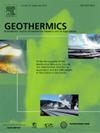不规则形状系统集成浅孔换热场新模型的开发与验证
IF 3.9
2区 工程技术
Q3 ENERGY & FUELS
引用次数: 0
摘要
在减少温室气体排放和减缓气候变化的背景下,需要精确和快速的钻孔热交换器(BHE)现场模型,可以集成到更广泛的系统层面,以设计和优化浅层地热区域供热和供冷电网的运行。现有的系统集成BHE现场模型需要进行调整,以满足所有要求(高短期和长期精度、低计算成本、不同的进口条件、不规则的现场几何形状)。在本研究中,开发了一个新的BHE场模型并在TRNSYS中实现。采用现有的热阻和电容模型来模拟井内的传热,以提高双u型管的短期精度。井壁温度由g函数的组合决定。提出的模型(DynIBF),包括建模的各个方面,使用现有的测量数据和模型进行验证。对于不规则BHE场,DynIBF模型是对现有模型的充分补充。不规则情况下的结果明显改善(平均绝对误差(MAE)比下一个最佳结果低0.63 K)。在给定的硬件上,DynIBF比已测试的现有TRNSYS模型快8%到41%。本文章由计算机程序翻译,如有差异,请以英文原文为准。
Development and validation of a new model for system-integrated shallow borehole heat exchanger fields with irregular geometry
In the context of reducing greenhouse gas emissions and mitigating climate change, accurate and fast borehole heat exchanger (BHE) field models that can be integrated into the broader system level are required for the design and operation optimisation of shallow geothermal district heating and cooling grids. Available system-integrated BHE field models need adaption in order to fulfil all requirements (high short- and long-term accuracy, low computational cost, varying inlet conditions, irregular field geometries). In this study, a new BHE field model is developed and implemented in TRNSYS. The heat transfer inside the borehole is modelled by adapting an existing thermal resistance and capacitance model for high short-term accuracy for double U-tubes. The borehole wall temperature is prescribed by a combination of g-functions. The proposed model (DynIBF), including various modelling aspects, is validated using existing measured data and models. DynIBF shows to be an adequate supplement to the existing models for irregular BHE fields. The results in the more irregular case are distinctly improved (mean absolute error (MAE) K from the next best result). On the given hardware, DynIBF is between 8% and 41% faster than the examined existing TRNSYS models.
求助全文
通过发布文献求助,成功后即可免费获取论文全文。
去求助
来源期刊

Geothermics
工程技术-地球科学综合
CiteScore
7.70
自引率
15.40%
发文量
237
审稿时长
4.5 months
期刊介绍:
Geothermics is an international journal devoted to the research and development of geothermal energy. The International Board of Editors of Geothermics, which comprises specialists in the various aspects of geothermal resources, exploration and development, guarantees the balanced, comprehensive view of scientific and technological developments in this promising energy field.
It promulgates the state of the art and science of geothermal energy, its exploration and exploitation through a regular exchange of information from all parts of the world. The journal publishes articles dealing with the theory, exploration techniques and all aspects of the utilization of geothermal resources. Geothermics serves as the scientific house, or exchange medium, through which the growing community of geothermal specialists can provide and receive information.
 求助内容:
求助内容: 应助结果提醒方式:
应助结果提醒方式:


